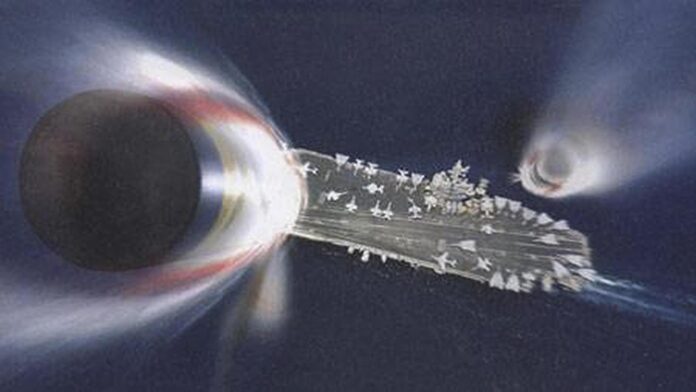OPINION: By Abhirup Sengupta, Military Aviation Enthusiast
It’s funny, the Anti Ship ballistic missiles are so “advanced” that we are yet to see a single ASh-ballistic missile hitting a mobile maritime target. Despite over a decade of hype, we’re still left with terrible CGI (Computer-generated imagery) to demonstrate such advanced weapon’s ability to hit maritime targets.
It’s ironic that people take ASh-ballistic missile’s effectiveness at face value while grossly undermine a Carrier Strike Group’s defenses, ignoring dozens of real-world data on SM-6 & SM-3’s performance.

It’s not impossible for AShBMs to hit a Carrier, but the entire kill chain is far more complicated than what most people assume. In the terminal phase, the ballistic missile warhead needs to perform velocity control manoeuvres to slow down, because they’ll be covered in plasma layer at Mach 10 – something that will blind the onboard seeker. This is the primary reason for those drastic “pull up and pull-down” manoeuvres, not to avoid Air Defences (which is a secondary effect).

Then it needs to search and acquire a target beneath while moving around Mach 5, having few seconds before it dives on to the target. Imagine having a narrow window to locate your target, a Carrier among several other ships deploying active decoys like Nulka and the heavy jamming environment – and this is assuming the ballistic missile could be guided in the vicinity of the Carrier, as the complicated flight path gives it only a small window to acquire a target.
None of Anti Ship Ballistic Missiles have demonstrated the ability to hit any maritime target
Today none of your ‘advanced’ AShBM (DF-21, Khinzhal, etc.) have demonstrated the ability to hit any maritime target even in ideal conditions – isolated target in absence of any decoy and jamming. This speaks volume to their real-world effectiveness and reliability – after all, a real-world test involving real target scores far better PR points than a terrible CGI.
And this is ignoring the practical challenges of locating the CSG and accurately tracking it from extremely long ranges. Over the Horizon (OTH) radars that many people boast are unaware of the fact that they too have huge blind spots, known as Skip zone. So while one may boast an OTH radar having a range of 3,000 nmi, in reality about half of the maximum range will be a blind spot.

Not to mention the fact that OTH radars don’t have the accuracy needed for targeting or that they’re far easier to jam due to very narrow bandwidth. Carriers are huge among military ships but not so among commercial ships.

And not only is the ocean immensely huge but it’s filled with commercial traffic – ships with comparable or even bigger size than Aircraft Carriers.

This is why it’s extremely difficult to track a deployed Carrier in real world, especially when it doesn’t want to be found (EMCON, monitoring satellite positions, ECMs). It takes huge resources, both large satellite constellations and manpower to reliably track a CSG in close to real time – resources that very few countries posses.
The entire kill chain for AShBMs – from accurately tracking the CSG, to guiding the ballistic missile in close vicinity, and then the AShBM’s seeker getting through the terminal stage is already so complicated and challenging that we haven’t seen a single real-world test. This is before adding Aegis interceptors and active decoys/jamming to the picture.
Meanwhile, countries marketing these Carrier-Killer weapons are busy building their own Carrier fleet or at least have full intention to build one if the economy allowed.


Despite all the threats and obsolesce-hype on the internet, when the shooting starts – the deployed Carriers will by far be the safest place compared to any other major base in the region.
Check out Naval Library App to find out the specifications of the missiles and aircraft carriers.



